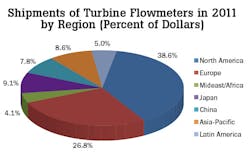Turbine Flowmeters: Low Cost, Improved Reliability Give Turbine Flowmeters Staying Power
Reinhard Woltman is generally credited with inventing the first turbine flowmeter in 1790. Woltman was a German engineer who dedicated his life to the Department of Ports and Navigable Waters of Hannover. One of his contributions was to study the loss of energy in open canals. One of his works on hydraulic theory was about hydraulic engineering, but included equations for calculating the loss of energy in pipes and canals. Today’s bulk turbine meters, used to measure water flow in larger quantities, are still called Woltman meters.
The turbine meter as it is used today had to await the invention of a pick-off sensor with a magnet and a rotating conductor. Using this means it is possible to count the number of rotations of the rotor on a turbine meter. This is essential for accurately measuring flow, since flowrate is proportional to the speed of the rotor. In the early 1940s, turbine meters were developed to accurately measure the consumption of fuel aboard military aircraft in World War II. Soon afterward turbine meters began to be used in the petroleum industry to measure the flow of hydrocarbons.
Turbine meters have a spinning rotor with propeller-like blades that are mounted on bearings in a housing. The rotor spins as water or other fluid passes over it. The rotor turns due to the force of the current. Flowrate is proportional to the rotational speed of the rotor. A variety of methods are used to detect the rotor speed, including a mechanical shaft and an electronic sensor.
Turbine meters differ according to the design of the spinning rotor. Several variations include paddlewheel meters and propeller meters. Paddlewheel meters have a rotor that has an axis of rotation that is parallel to the direction of the flow. Many paddlewheel meters are insertion devices. Propeller meters have a rotor that is suspended in the flowstream. These meters are used mainly for liquid applications.
Axial turbine meters have a rotor that revolves around the axis of flow. Most flowmeters for oil measurement and for measuring industrial liquids and gases are axial flowmeters. Axial meters differ according to the number of blades and the shape of the rotors. Axial meters for liquids have a different design from axial meters for gas applications.
The history of using turbine meters to measure gas flow goes back to 1953. Rockwell (www.rockwellautomation.com) introduced a turbine meter to the gas industry in 1963. It took about 10 years for turbine meters to become widely accepted by the gas industry for measuring flow. In 1981, the American Gas Association (www.aga.org) published its Report #7, “Measurement of Fuel Gas by Turbine Meters.” Since that time, turbine meters have been solidly established in the gas industry as a measurement device, especially for custody-transfer applications.
There are several reasons why turbine meters will continue to maintain their wide usage for gas and liquid flow applications. One is that turbine meters have a significant cost advantage over ultrasonic meters, especially in the larger pipe sizes. Their price may also compare favorably to DP flowmeters, especially in cases where one turbine meter can replace several DP meters. Users who are already familiar with turbine technology, and who don’t want to spend the extra money required to invest in a new technology, are likely to stay with turbine meters.
Secondly, turbine meter suppliers are making technology improvements to make turbine meters more reliable. Many of these improvements involve making the moving parts more reliable. By making the ball bearings out of more durable material, such as ceramic or sapphire, turbine suppliers have been able to add significantly to the life of the bearings. This is important because some customers select new-technology meters over turbine meters because turbine meters have moving parts.
For more information on Flow Research’s work in the area of turbine flow measurement, visit www.FlowTurbine.com.
Jesse Yoder
Jesse Yoder, Ph.D., is president of Flow Research Inc. He has 30 years of experience as an analyst and writer in instrumentation. Yoder holds two U.S. patents on a dual-tube meter design and is the author of "The Tao of Measurement," published by ISA. He may be reached at [email protected]. Find more information on the latest study from Flow Research, "The World Market for Gas Flow Measurement, 4th Edition," at www.gasflows.com.



